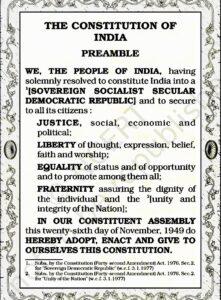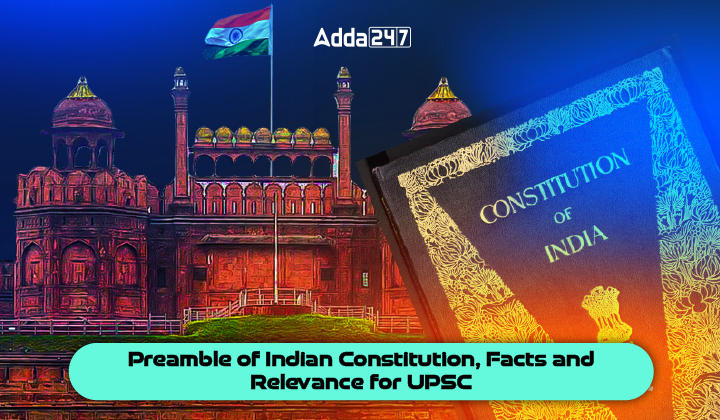Table of Contents
Introduction to Preamble: The “Preamble” of the Constitution of India serves as a concise introduction outlining the fundamental purposes and principles of the document. It signifies the origin from which the Constitution draws its authority, namely, the people. Adopted on November 26, 1949, by the Constituent Assembly of India, it officially came into effect on January 26, 1950.
Within the realm of the Indian Polity, the preamble holds significant importance, particularly in the context of the IAS Exam. Therefore, this article aims to delve into the preamble of the Indian Constitution, shedding light on its contents and significance. Additionally, it explores the Objective Resolution, which, in its adapted form, finds reflection in the preamble of India.
Objective Resolution of Preamble
In 1946, Jawaharlal Nehru proposed the Objective Resolution, delineating the constitutional framework. On January 22, 1947, it was officially adopted. This resolution played a pivotal role in shaping the Constitution of India, and a revised rendition of it is evident in the preamble of the Indian Constitution. The fundamental principles emphasized by the Objective Resolution included:
- The Constituent Assembly aims to envision India as independent, sovereign, and republican.
- It seeks to draft a Constitution tailored to the needs of India.
- The goal is to unite all territories of pre-independent India into the United States of post-independent India.
- The Assembly aims to grant residual powers and autonomy to states as outlined in the Constitution of India.
- It intends to establish a union with powers distinct from those granted to individual states.
- The people of India are recognized as the source of power and authority, ensuring sovereignty and independence.
- The Assembly aims to ensure justice, social, economic, and political equality, along with freedom of thought, expression, belief, faith, worship, vocation, association, and action, within law and public morality.
- Adequate safeguards are to be provided for minorities, tribal and backward areas, and other marginalized classes.
- It is committed to upholding the integrity of the Indian Republic’s territory and territorial rights on land, sea, and air, under international justice and law.
- Promoting peace and welfare among nations is a paramount objective.
The topic, ‘Preamble of India’ is important for Indian Polity subject. Questions can be asked from it in both prelims and mains.
Preamble of India – Facts for UPSC
The Preamble of India, adopted on November 26, 1949, embodies the foundational principles and aspirations of the nation, marking the commencement of its sovereign journey on January 26, 1950. It reflects the collective will of the people and serves as a guiding light for the country’s democratic ethos and inclusive governance, integral to the understanding of India’s constitutional framework, making it a crucial topic for UPSC aspirants.
| Is the preamble part of the Indian Constitution? | Yes, it is a part of the Indian constitution, also emphasized in Kesavananda Bharti Case. |
| Who wrote the preamble of India? | The preamble of India contains tenets highlighted in the Objective Resolution drafted by Jawaharlal Nehru in 1946 |
| How many preambles does the Indian Constitution have? | With only 1 preamble along with 25 parts 12 schedules and 448 articles, the Indian Constitution today exists |
| What is the most important word in the Preamble of India? | Though no particular word has been given more importance than others, ‘We, the people of India’ are the words that are termed as the most powerful in the Preamble to the Indian Constitution |
| Why do we need a Preamble? | It gives us fundamental values and highlights of the Constitution |
| In which case, did the Supreme Court declare passed a judgement that the Preamble is not a part of the Indian Constitution? | In the Berubari Case (1960), the SC declared the Preamble not to be a part of the Indian Constitution |
The preamble articulates the people’s hopes, aspirations, and national ideals in unequivocal terms, embodying the essence of the Constitution, akin to its soul. It serves as the introductory preface, succinctly outlining the overarching principles and objectives that define the entirety of the Constitution.
Interesting Facts about Preamble of India
- The addition of the term ‘secular’ to the Preamble of the Indian Constitution occurred after the enactment of the entire Constitution.
- The 42nd Constitutional Amendment Act of 1976 introduced the term ‘secular’ into the Preamble.
- The Preamble guarantees all Indian citizens the freedom of belief, faith, and worship.
- The concept of justice (social, economic, and political) in the Preamble draws inspiration from the Constitution of the Soviet Union (Russia).
- The notions of Republic and the ideals of liberty, equality, and fraternity find their roots in the French Constitution.
- The Preamble itself was initially introduced through the American Constitution.

Four Main Ingredients of Preamble of India
The Indian Preamble encapsulates the origins of the Constitution, the essence of the Indian State, the fundamental objectives it aims to achieve, and the significant date of its adoption. These four core elements are pivotal components of the Preamble of India, detailed in the table below for your reference:
| Preamble of India – Four Main Ingredients | |
| Source of the Indian Constitution | The People of India are revealed to be the source of the authority of the Indian Constitution. The words, ‘We, the People of India’ reflect the same. |
| Nature of the Indian State | The Preamble of India tags India as a sovereign, socialist, republic, secular and democratic nation |
| Objective of the Indian Constitution | Justice, Liberty, Equality and Fraternity are denoted as the objectives of the Preamble of India |
| Adoption Date of the Constitution of India | November 26, 1949, as the date when then the Indian Constitution |
Preamble of Indian Constitution- Keywords
In the Preamble of India, there are important keywords like:
- Sovereign
- Socialist
- Secular
- Democratic
- Republic
- Justice
- Liberty
- Equality
- Fraternity



 TSPSC Group 1 Question Paper 2024, Downl...
TSPSC Group 1 Question Paper 2024, Downl...
 TSPSC Group 1 Answer key 2024 Out, Downl...
TSPSC Group 1 Answer key 2024 Out, Downl...
 Cabinet Ministers of India 2024, New Cab...
Cabinet Ministers of India 2024, New Cab...







